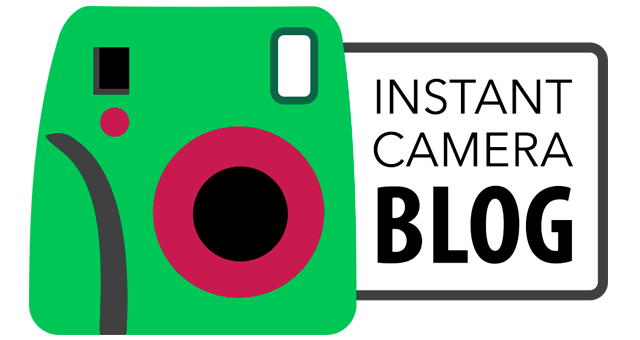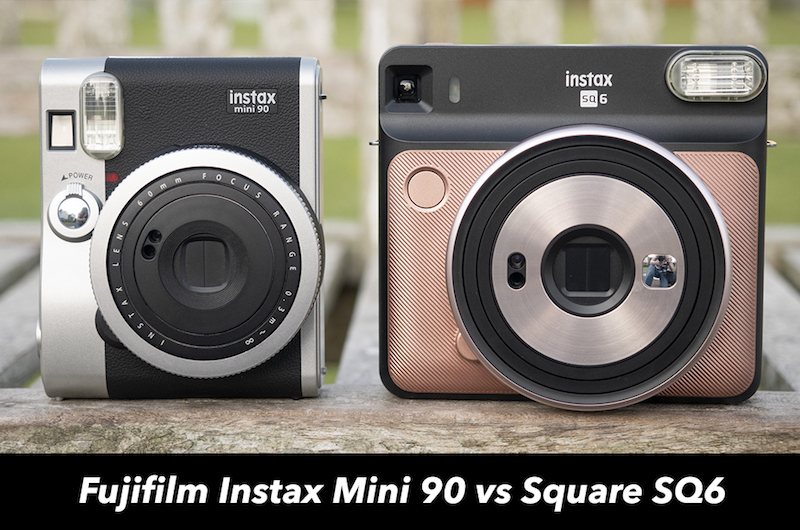When most people think of Instax cameras, the first models that usually come to mind are the extremely popular Mini 8 and its successor, the Mini 9. But they are far from the only Instax cameras on the market today.
Two models with more advanced settings than the Mini 8 and 9 are the Instax Square SQ6 and the Instax Mini 90 Neo Classic. The former is a brand new instant camera that uses the Instax Square film format while the latter is the premium model in the Mini range.
In this article, we’re going to be taking a look at all the differences between them. Let’s begin!
Ethics statement: We bought the Instax Square SQ6 and Instax Mini 90 Neo Classic for our personal use. All opinions about these two cameras are our own. Within this article, there are affiliate links. If you buy something after clicking the link, we will receive a small commission. To know more about our ethics, you can visit our full disclosure page. Thank you!
1. Film format and image quality
As we already revealed in the introduction, the SQ6 uses the Instax Square format which is the same height as the Mini format (around 62cm), but noticeably wider. The Mini 90, by contrast, uses the Instax Mini format just like the Mini 8 and 9 cameras.
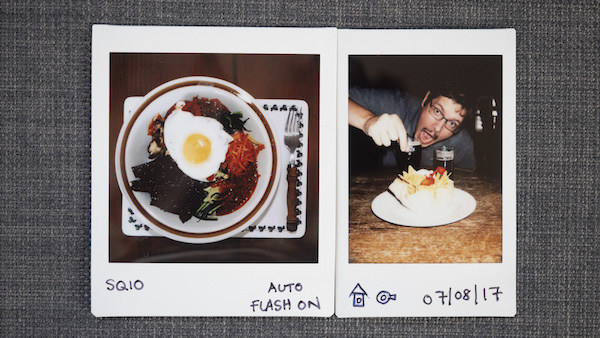
Because the emulsion and development process are the same, the image quality is pretty much identical in terms of detail reproduction and colour.
However it isn’t uncommon for the two cameras to meter the same scene differently as you can see below.
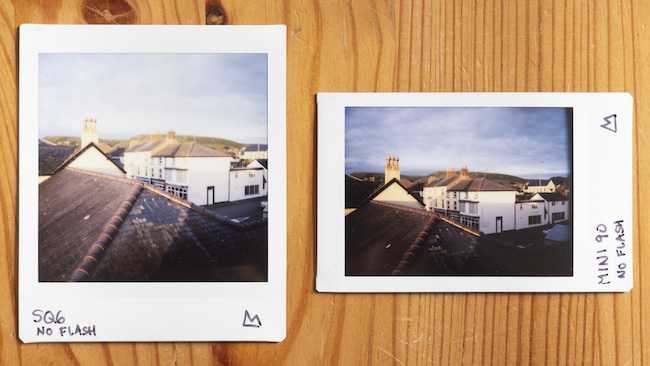
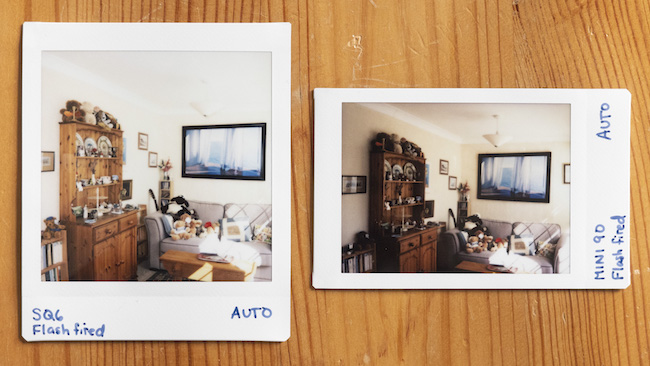
If the metering does happen to be the same and the flash doesn’t influence the final result – either because it doesn’t fire or because you’re shooting a distant outdoor subject – you’ll generally end up with a very similar result.
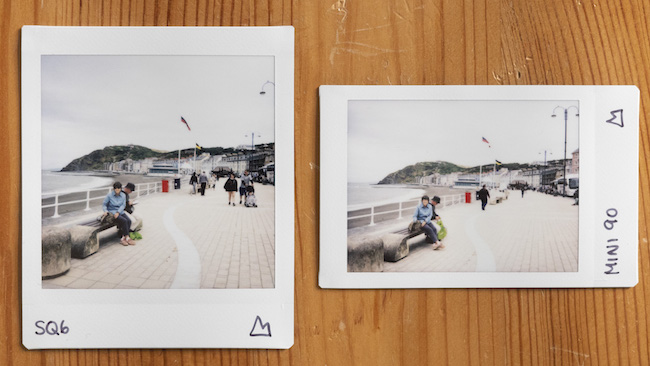
2. Design
Of all the Instax cameras in existence, I would say that the SQ6 and Mini 90 are the most similar in terms of design. For instance, both have a bicoloured body that is square in shape. (Most other models are rounder and come in one solid colour.) There are some differences worth pointing out however, so let’s dive straight in.
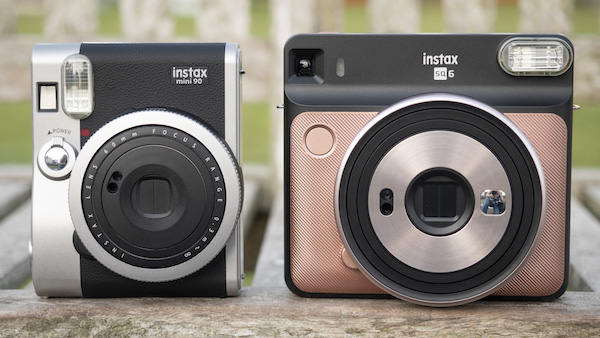
The first thing you’ll notice is that the SQ6 is larger and heavier than the Mini 90. This is because it has to accommodate the larger film format mentioned above. You can see the precise measurements below:
- Square SQ6: 118.7 x 128.1 x 58.1mm | 393g (without battery and film pack)
- Mini 90: 113.4 x 91.9 x 57.2mm | 296g (without battery and film pack)
The SQ6’s textured covering also comes in a different range of colours: blush gold, graphite gray and pearl white. The Mini 90 is only available in two classic combinations: black/silver and brown/silver.
Although most of the controls and features are similar, they tend to be located in different points around the body. For example, the SQ6’s on/off switch is located on top beside the film ejection slot while the Mini 90’s on/off toggle found beside the lens.
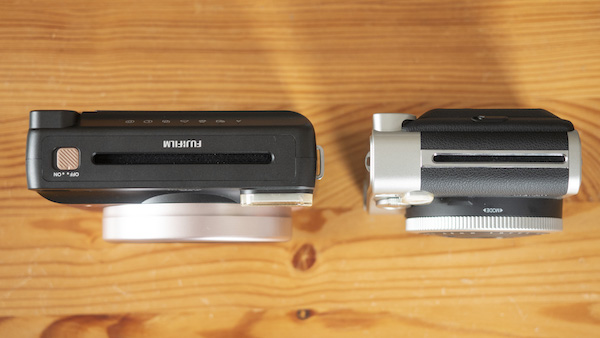
Interestingly the Mini 90 has not one but two shutter buttons to facilitate horizontal and vertical shooting. One is located inside the on/off toggle while the other is found on the silver top plate.
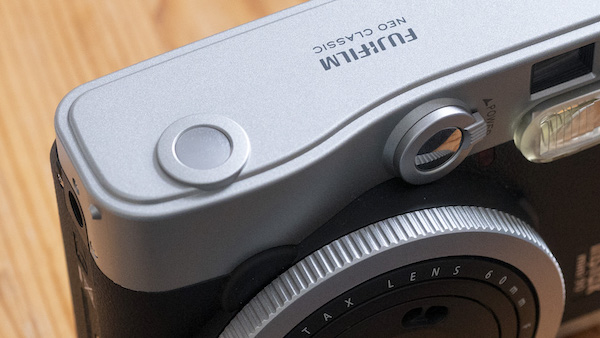
Both feature a film ejection slot, shutter button, flash, light meter, film door and optical viewfinder.
3. Optical viewfinder
Both cameras sport a built-in optical viewfinder albeit with slightly different specifications.
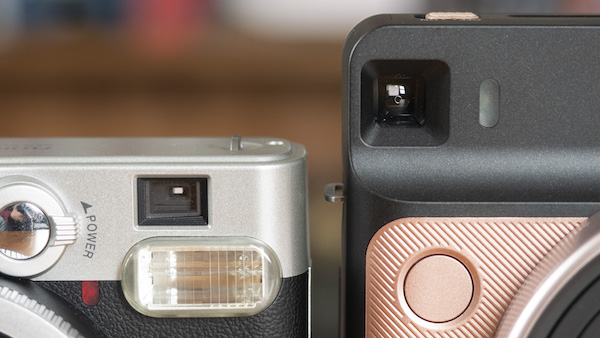
The Mini 90 uses a rectangular real image finder with 0.37x magnification whereas the SQ6 uses a square-shaped Inverted Galilean finder with 0.4x magnification. The SQ6 finder is more comfortable to look through due to its size but the Mini 90’s has a crisper border.
When you switch to macro mode on the Mini 90, the finder adjusts the composition to correct for parallax error. What is parallax? Put simply, it is a phenomenon whereby the image you see through the viewfinder at close working distances is slightly offset compared to what the lens sees. This is due to the fact that the viewfinder and lens aren’t on the same optical axis.
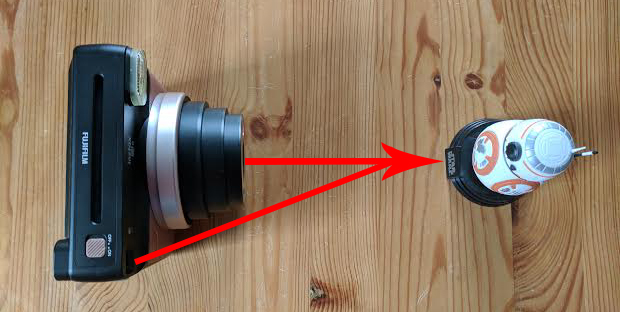
The SQ6 doesn’t have parallax correction built in, so some guesswork is necessary in order to create a perfectly centred image at close working distances.
Both finders have a target circle in the centre to help you compose.
4. Lens
It is pretty hard to miss the large lens that occupies the front of both cameras. Both extend from the body when you turn the camera on.
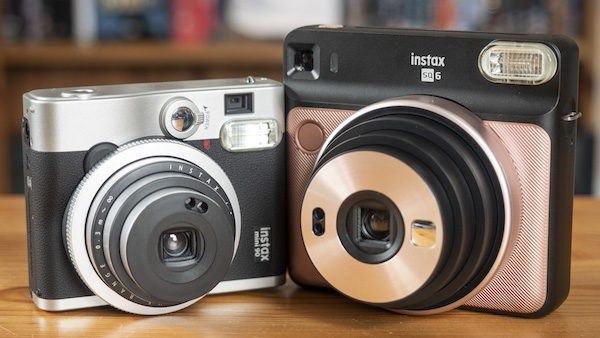
The Mini 90 offers a marginally slower maximum aperture (f/12.7 vs. f/12.6) and slightly shorter focal length of 60mm, which equates to around 34mm in 35mm format. (The SQ6 has a 65.75mm lens which is the equivalent of approximately 32mm in 35mm format.)
The lens of the Mini 90 is surrounded by a control ring that lets you switch between modes, whereas the SQ6 has a mirror on the front of the lens to help you compose accurate selfies. This is a feature it shares with beginner-friendly models like the Mini 9 and 70.
5. Focusing range
Along with having slightly different focal lengths, the two cameras also focus at different ranges depending on the settings you choose.
In macro mode, the Mini 90 can shoot at any distance between 30cm and 60cm, whereas the SQ6 is more limited (30cm to 50cm). Switch to normal (auto) mode and the range becomes 60cm to 3m on the Mini 90 or 50cm to 2m on the SQ6.
Finally in landscape mode, the Mini 90 can shoot between 3m to infinity while the SQ6 starts at 2m.
6. Battery type
One thing I love about the Mini 90 is that it uses a rechargeable battery just like Fujifilm’s digital cameras. On average, you can shoot 10 Instax Mini film packs before the battery runs out, but if you don’t use the camera for a while, it will slowly drain on its own.

The SQ6 uses two CR2 lithium batteries just like the Mini 70 and is able to take approximately 30 Instax Square packs before they need to be changed. I would have preferred a rechargeable battery – or at the very least standard AA batteries since they’re easier to find – but I guess the designers at Fujifilm had their reasons for choosing this particular type.
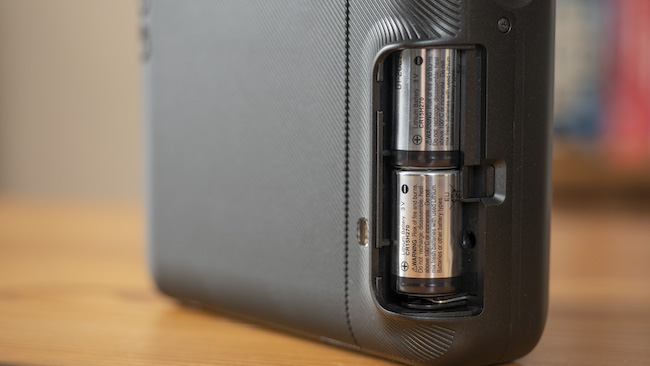
7. Shutter speed
A very small difference between the two cameras concerns the shutter speed range.
Although both have a maximum shutter speed of 1/400 of a second, the minimum shutter speed is ever so slightly longer on the SQ6 (1.6s versus 1.8s).
Exposure is fully automatic on both cameras, so you have no control over the shutter speed they choose in any given situation. The only exception is Bulb mode on the Mini 90 which keeps the shutter open for up to 10 seconds when the shutter button is depressed.
8. Flash
Both cameras come with a built-in flash that emits the ideal amount of the light according to the distance to the subject and ambient brightness. This helps to optimise the exposure. Both have an effective flash range of 30cm to 2.7m.
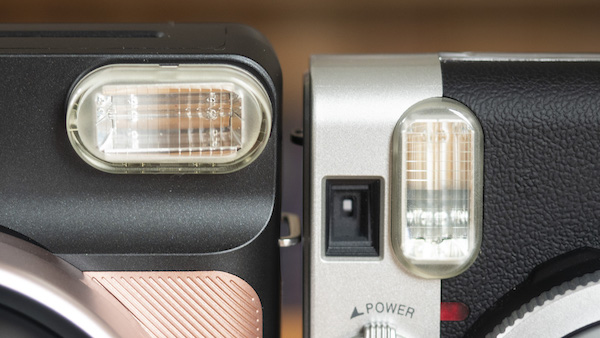
You can suppress the flash on either model by pressing the flash button on the rear.
Two extra flash modes you’ll only find on the Mini 90 are forced firing flash and red eye reduction. The SQ6, on the other hand, comes bundled with three colourful flash filters that, when attached to the flash, change the tint of your image.
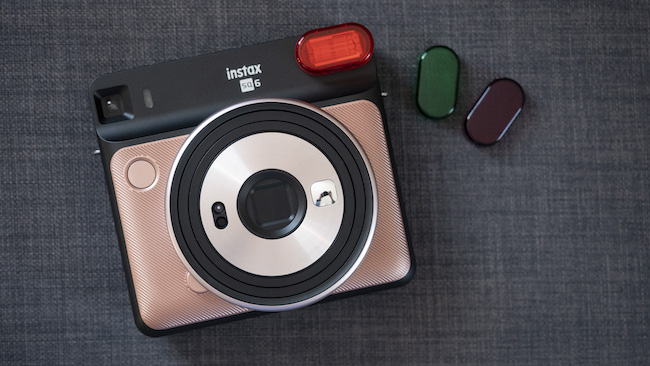
Something curious I’ve noticed is that the flash will sometimes fire on one camera but not on the other despite all conditions – including the light, subject, setting and camera mode – being the same. For example, only the Mini 90 fired the flash for the first two selfies below which I took in Macro mode. To get the flash to fire, I had to switch to the dedicated Selfie mode on the SQ6.
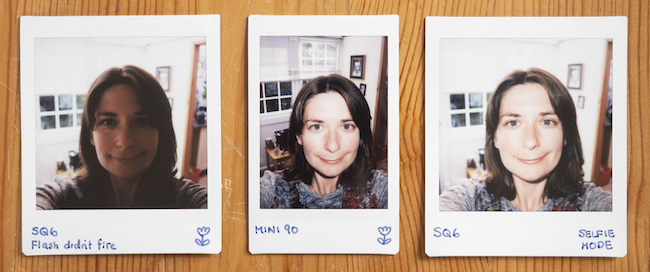
9. Photography modes
While the photography modes on the SQ6 and Mini 90 are quite similar overall, there are a few small differences worth pointing out.
In addition to the Lighten and Darken settings found on both cameras, the Mini 90 comes with an additional Lighten+ mode which raises the exposure by +1EV. (L and D on their own compensate by ±2/3EV.)
Landscape, Macro, Double Exposure and Self Timer are all found on both models but only the Mini 90 has the Party and Kids modes. The former enables the subject and background to be captured brightly, while the latter helps you capture moving subjects like children and animals in low-light and cloudy conditions. I’ve only used these modes a couple of times to be honest, so I don’t really miss them when I’m shooting with the SQ6.
The only mode the SQ6 has that the Mini 90 does not is the Selfie mode, which is essentially the same as Macro in that it reduces the focus range to 30-50cm.
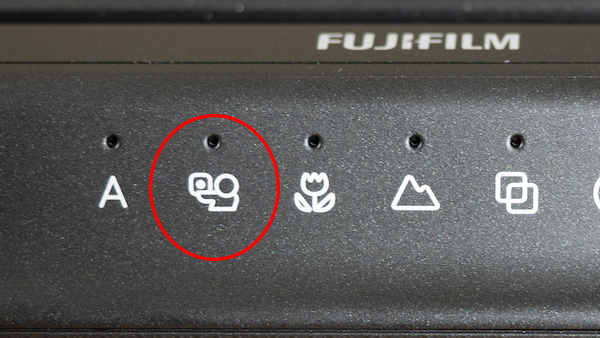
A big advantage of the Mini 90 is that you can combine certain modes. For example, if you want to shoot a landscape image on a sunny day, you can combine Landscape and Darken to reduce the chance of overexposing your image. Likewise, you can activate the Macro mode while taking double exposures of subjects that need to be photographed up close, such as faces and flowers.
With the SQ6, you can only choose one mode at a time, making it less versatile for certain genres. For instance, if you choose Landscape, you cannot darken the exposure, and if you choose Darken, you’ll be limited to the focus range offered by the Auto mode (50cm – 2m). The only exception is the flash which can be suppressed in any mode.
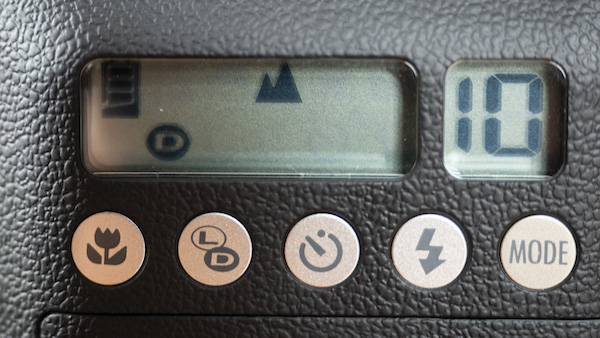
10. Rear display
To switch between the aforementioned modes on the SQ6, all you have to do is repeatedly press the Mode button on the rear and the camera will scroll through the icons on top. When a setting is selected, the small bulb above the corresponding icon will light up.
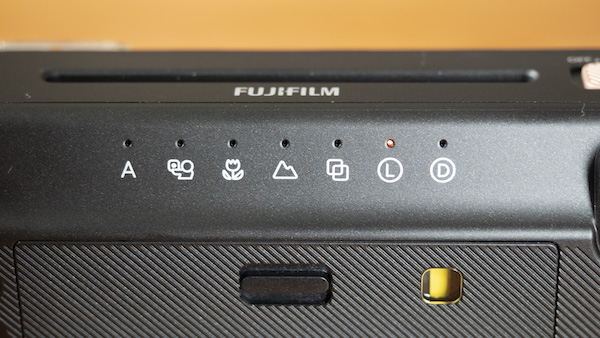
The Mini 90 may be analog but it does have one digital feature: a rear LED display. It works in the same way as the SQ6 in that you have to press the Mode button multiple times in order to scroll through the options.
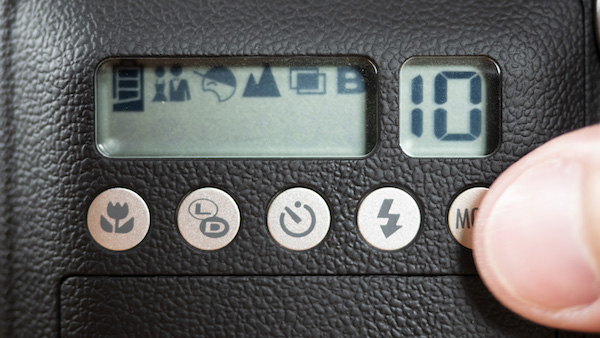
Conclusion
Were I on the brink of buying my first Instax camera and had narrowed my decision down to the Square SQ6 and Mini 90, I admit I would have a very hard time choosing between them!
On one hand, I really love the SQ6 because it prints using the Square film format whose larger image area is much easier to see than that of the Mini format.
But on the flip side, I do appreciate the extra modes of the Mini 90 and more specifically, how you can combine some of them to improve your chances of taking a good shot. The fact that the battery is rechargeable is also a bonus, not only because it is more environmentally friendly but also because it is less expensive than buying new batteries on a regular basis.
My hope is that one day, Fujifilm will release an SQ model that synthesises the best of both worlds but until then, I think I’ll keep using them both!
Check price of the Instax Square SQ6 on
Amazon | Amazon UK | B&H Photo | eBay
Check price of the Mini 90 on
Amazon | Amazon UK | B&H Photo
How about you? Which Instax model do you prefer and why? Share your thoughts below!
